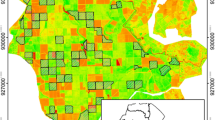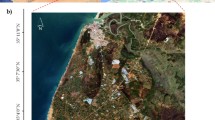Abstract
Information on rubber tree (Hevea brasiliensis) areas and stages of rubber tree growth is needed in making decisions to maximise land use and for efficient farm management. The use of conventional methods in collecting this information requires a long time, high costs, and constraints to access certain areas. Therefore, this study was conducted to evaluate Landsat-8 OLI and Sentinel-2 images in detecting and mapping the rubber tree area. This study presents a pixel-based supervised classification approach to obtain an accurate map of land cover and rubber tree growth stage distribution using resampled 10 m spatial resolution of Sentinel-2 and pansharpened 15 m Landsat-8 OLI. Seven land cover classes (bare soil, water, mature rubber, immature rubber, oil palm, forest, and built-up area) were classified using support vector machine (SVM), artificial neural network (ANN) and spectral angle mapper (SAM). The results showed that the highest classification accuracy was obtained using SVM, 87.22% for Sentinel-2 and 85.74% for Landsat-8. Next, the classification accuracies of ANN were almost similar with 86.17% and 82.39% for Sentinel-2 and Landsat-8, respectively. SAM has produced less than 60% of acceptable accuracy for both datasets. The performance of the aforementioned classifiers was statistically tested using a McNemar test. The test showed that the p-value between SVM and ANN was not significant and thus, ANN and SVM produced similar accuracies and outperformed SAM for both cases. In this study, the best output produced via SVM from Sentinel-2 was selected to produce the thematic map due to the spatial accuracy advantage of Sentinel-2 compared to Landsat-8. The calculated areas of immature and mature rubber from the thematic map were 7.79 km2 and 10.93 km2, respectively, which then used to estimate the number of tappers needed for the management of rubber. It is concluded that the Sentinel-2 Multispectral Instrument (MSI) data can be recommended to be used in rubber cultivation area assessment.











Similar content being viewed by others
References
Mooibroek H, Cornish K (2000) Alternative sources of natural rubber. Appl Microbiol Biotechnol 53:355–365. https://doi.org/10.1007/s002530051627
Malaysian Rubber Board (2018) Natural rubber statistic Jan–Dec 2018. http://www.lgm.gov.my/nrstat/Statistics%20Website%202018%20(Jan-Dec).pdf. Accessed 20 Dec 2019
Saufe NA (2017) Social adaptation level towards unstable rubber price among malaysian rubber smallholders. IOSR J Agric Vet Sci 10:29–32. https://doi.org/10.9790/2380-1002022932
Malaysian Rubber Board (2020a) SMR 20 price chart (2010–2019). http://www3.lgm.gov.my/mre/pdf/Poster%202010-2019-f.pdf. Accessed 3 Jan 2020
Waldner F, De Abelleyra D, Verón SR, Zhang M, Wu B, Plotnikov D, Bartalev S et al (2016) Towards a set of agrosystem-specific cropland mapping methods to address the global cropland diversity. Int J Remote Sens 37:3196–3231. https://doi.org/10.1080/01431161.2016.1194545
Li Q, Wang C, Zhang B, Lu L (2015) Object-based crop classification with Landsat-MODIS enhanced time-series data. Remote Sens 7:16091–16107. https://doi.org/10.3390/rs71215820
Gao F, Anderson MC, Zhang X, Yang Z, Alfieri JG, Kustas WP et al (2017) Toward mapping crop progress at field scales through fusion of Landsat and MODIS imagery. Remote Sens Environ 188:9–25. https://doi.org/10.1016/j.rse.2016.11.004
Gallego FJ, Kussul N, Skakun S, Kravchenko O, Shelestov A, Kussul O (2014) Efficiency assessment of using satellite data for crop area estimation in Ukraine. Int J Appl Earth Obs Geoinf 29:22–30. https://doi.org/10.1016/j.jag.2013.12.013
Clevers JGPW, Kooistra L, van den Brande MMM (2017) Using Sentinel-2 data for retrieving LAI and leaf and canopy chlorophyll content of a potato crop. Remote Sens 9:405–419. https://doi.org/10.3390/rs9050405
Delloye C, Weiss M, Defourny P (2018) Retrieval of the canopy chlorophyll content from Sentinel-2 spectral bands to estimate nitrogen uptake in intensive winter wheat cropping systems. Remote Sens Environ 216:245–261. https://doi.org/10.1016/j.rse.2018.06.037
Veysi S, Naseri AA, Hamzeh S, Bartholomeus H (2017) A satellite based crop water stress index for irrigation scheduling in sugarcane fields. Agric Water Manag 189:70–86. https://doi.org/10.1016/j.agwat.2017.04.016
Marin DB, de Carvalho AM, Pozza EA, Belan LL, de Freitas MLO (2019) Multispectral radiometric monitoring of bacterial blight of coffee. Precis Agric 20:959–982. https://doi.org/10.1007/s11119-018-09623-9
Nguyen HTT, Doan TM, Radeloff V (2018) Applying random forest classification to map land use/land cover using Landsat 8 OLI. Int Arch Photogramm Remote Sens Spatial Inf Sci 42:363–367. https://doi.org/10.5194/isprs-archives-XLII-3-W4-363-2018
Han P, Chen J, Han Y, Yi L, Zhang Y, Jiang X (2018) Monitoring rubber plantation distribution on Hainan Island using Landsat OLI imagery. Int J Remote Sens 39:2189–2206. https://doi.org/10.1080/01431161.2017.1420933
Fan H, Fu X, Zhang Z, Wu Q (2015) Phenology-based vegetation index differencing for mapping of rubber plantations using landsat OLI data. Remote Sens 7:6041–6058. https://doi.org/10.3390/rs70506041
Xiao C, Li P, Feng Z (2019) A renormalized modified normalized burn ratio (RMNBR) index for detecting mature rubber plantations with Landsat-8 OLI in Xishuangbanna, China. Remote Sens Lett 10:214–223. https://doi.org/10.1080/2150704X.2018.1541106
Hazir MHM, Muda TMT (2018) The viability of remote sensing for extracting rubber smallholding information: a case study in Malaysia. Egypt J Remote Sens Space Sci 23:35–47. https://doi.org/10.1016/j.ejrs.2018.05.001
Dibs H, Idrees MO, Alsalhin GBA (2017) Hierarchical classification approach for mapping rubber tree growth using per-pixel and object-oriented classifiers with SPOT-5 imagery. Egypt J Remote Sens Space Sci 20:21–30. https://doi.org/10.1016/j.ejrs.2017.01.004
Dibs H, Mansor S (2014) Mapping rubber tree growth by spectral angle mapper spectral-based and pixel-based classification using SPOT-5 image. In: 35th Asian conference on remote sensing 2014, ACRS 2014: sensing for Reintegration of Societies.
Razak JAA, Shariff ARM, Ahmad N, Sameen MI (2018) Mapping rubber trees based on phenological analysis of Landsat time series data-sets. Geocarto Int 33:627–650. https://doi.org/10.1080/10106049.2017.1289559
Malaysian Rubber Board (2014) Panduan Ladang 2014. Stesen Penyelidikan Kota Tinggi, Lembaga Getah Malaysia
Trimble Navigation (1996) Trimble Pathfinder Office Software Reference Guide. Trimble Navigation, Ltd., Sunnyvale, CA, p 432
ESRI (2011) ArcGIS Desktop: Release 10. Environmental Systems Research Institute, Redlands, CA
Harris Geospatial Solutions (2016) Using ENVI; Harris Geospatial Solutions: Broomfield, CO, USA. http://www.harrisgeospatial.com/docs/routines-136.html. Accessed 26 Aug 2020
PCI Geomatics, Geomatica Online Help (2018) Available online: http://www.pcigeomatics.com/geomatica-help/. Accessed 29 June 2019
Shaharum NSN, Shafri HZM, Gambo J, Abidin FAZ (2018) Mapping of Krau Wildlife Reserve (KWR) protected area using Landsat 8 and supervised classification algorithms. Remote Sens Appl Soc Environ 10:24–35. https://doi.org/10.1016/j.rsase.2018.01.002
SNAP (2016) Snap Open Source Software. http://step.esa.int/main/toolboxes/snap/. Accessed 26 Jan 2019
Richter R (2007) Atmospheric/topographic correction for satellite imagery. https://www.dlr.de/eoc/en/Portaldata/60/Resources/dokumente/5_tech_mod/atcor3_manual_2012.pdf. Accessed 20 Dec 2019
Mountrakis G, Im J, Ogole C (2011) Support vector machines in remote sensing: a review. ISPRS J Photogramm Remote Sens 66:247–259. https://doi.org/10.1016/j.isprsjprs.2010.11.001
Kuo BC, Ho HH, Li CH, Hung CC, Taur JS (2014) A kernel-based feature selection method for SVM with RBF kernel for hyperspectral image classification. IEEE J Select Top Appl Earth Obs Remote Sens 7:317–326. https://doi.org/10.1109/JSTARS.2013.2262926
Keshtkar H, Voigt W, Alizadeh E (2017) Land-cover classification and analysis of change using machine-learning classifiers and multi-temporal remote sensing imagery. Arab J Geosci 10:1–15. https://doi.org/10.1007/s12517-017-2899-y
Number of nodes in the layers for neural net (2013). https://www.l3harrisgeospatial.com/Support/Maintenance-Detail/ArtMID/13350/ArticleID/19285. Accessed 1 July 2020
Mas JF, Flores JJ (2008) The application of artificial neural networks to the analysis of remotely sensed data. Int J Remote Sens 29:617–663. https://doi.org/10.1080/01431160701352154
Harris Geospatial Solutions (2017) Spectral angle mapper. Exelis Visual information solutions, Inc. https://doi.org/10.1002/(SICI)1096-9926(199606)54:2<84::AID-TERA4>3.0.CO;2-4
Shang K, Zhang L, Xie Y (2011) Evaluation of hyperspectral classification methods based on FISS data. In MIPPR 2011: multispectral image acquisition. Process Anal 8802:1–8. https://doi.org/10.1117/12.902908
Congalton RG (1991) A review of assessing the accuracy of classifications of remotely sensed data. Remote Sens Environ 37:35–46. https://doi.org/10.1016/0034-4257(91)90048-B
Phinn SR, Roelfsema CM, Mumby PJ (2012) Multi-scale, object-based image analysis for mapping geomorphic and ecological zones on coral reefs. Int J Remote Sens 33:3768–3797. https://doi.org/10.1080/01431161.2011.633122
Aziz AA (2014) Integrating a Redd + Project into the Management of a Production Mangrove Forest in Matang Forest Reserve, Malaysia. Dissertation, University of Queensland, Australia
Kamal M, Phinn S, Johansen K (2015) Object-based approach for multi-scale mangrove composition mapping using multi-resolution image datasets. Remote Sens 7:4753–4783. https://doi.org/10.3390/rs70404753
Trajman A, Luiz RR (2008) McNemar χ2 test revisited: comparing sensitivity and specificity of diagnostic examinations. Scand J Clin Lab Invest 68:77–80. https://doi.org/10.1080/00365510701666031
Fagerland MW, Lydersen S, Laake P (2013) The McNemar test for binary matched-pairs data: mid-p and asymptotic are better than exact conditional. BMC Med Res Methodol 13:91–98
Dwyer AJ (1991) Matchmaking and McNemar in the comparison of diagnostic modalities. Radiology 178:328–330. https://doi.org/10.1148/radiology.178.2.1987587
Foody GM (2009) Sample size determination for image classification accuracy assessment and comparison. Int J Remote Sens 30:5273–5291. https://doi.org/10.1080/01431160903130937
Foody GM (2004) Thematic map comparison. Photogramm Eng Remote Sens 70:627–633. https://doi.org/10.1458/PERS.70.5.627
Malaysian Rubber Board (2009) Rubber plantation and processing technologies, 1st edn. Malaysia Rubber Board, Serdang, p 301 (ISBN: 978-983-2088-31-8)
Yonezawa C (2007) Maximum likelihood classification combined with spectral angle mapper algorithm for high resolution satellite imagery. Int J Remote Sens 28:3729–3737. https://doi.org/10.1080/01431160701373713
Park B, Windham WR, Lawrence KC, Smith DP (2007) Contaminant classification of poultry hyperspectral imagery using a spectral angle mapper algorithm. Biosyst Eng 96:323–333. https://doi.org/10.1016/j.biosystemseng.2006.11.012
Cho MA, Debba P, Mathieu R, Naidoo L, Van Aardt JAN, Asner GP (2010) Improving discrimination of savanna tree species through a multiple-endmember spectral angle mapper approach: canopy-level analysis. IEEE Trans Geosci Remote Sens 48:4133–4142. https://doi.org/10.1109/TGRS.2010.2058579
Shafri HZM (2016) Machine learning in hyperspectral and multispectral remote sensing data analysis. Artif Intell Sci Technol. https://doi.org/10.1142/9789813206823_0001
Acknowledgements
Authors would like to thank Universiti Putra Malaysia (UPM) and Malaysian Rubber Board, for their support and facilities throughout the project. Comments from anonymous reviewers towards the improvement of the paper are highly appreciated.
Author information
Authors and Affiliations
Corresponding author
Ethics declarations
Conflict of interest
The authors whose names are listed immediately below certify that they have no affiliations with or involvement in any organisation or entity with any financial interest or non-financial interest in the subject matter or materials discussed in this manuscript.
Additional information
Publisher's Note
Springer Nature remains neutral with regard to jurisdictional claims in published maps and institutional affiliations.
Rights and permissions
About this article
Cite this article
Yusof, N., Shafri, H.Z.M. & Shaharum, N.S.N. The use of Landsat-8 and Sentinel-2 imageries in detecting and mapping rubber trees. J Rubber Res 24, 121–135 (2021). https://doi.org/10.1007/s42464-020-00078-0
Received:
Accepted:
Published:
Issue Date:
DOI: https://doi.org/10.1007/s42464-020-00078-0




